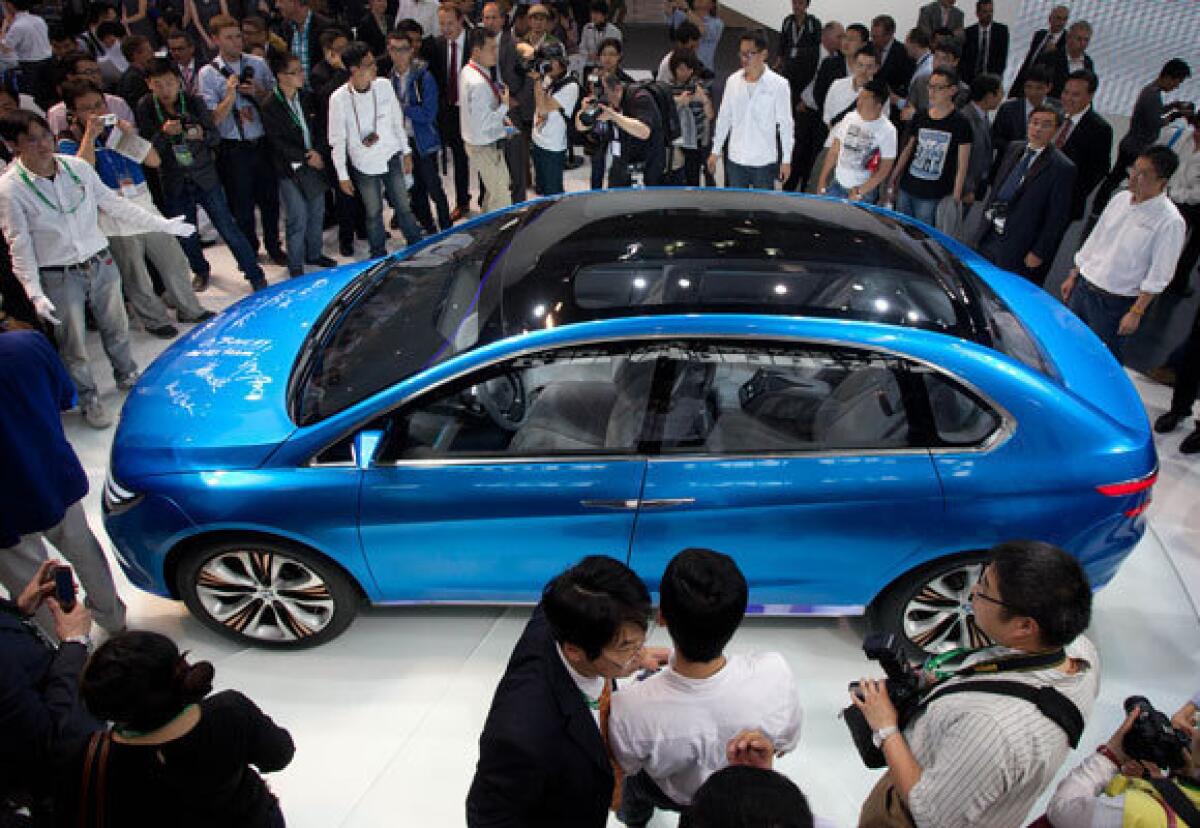EV confab this weekend is about more than cars

The electric car might not be enjoying a good moment as the Electric Vehicle Symposium, EVS26, powers up for its run this weekend at the Los Angeles Convention Center. GM stopped production for five weeks on the Chevy Volt, and sales of new all-electric cars such as the Volt or the Nissan Leaf are dismal. It’s further evidence that transitioning American drivers to electric vehicles (EV) is simply a hard sell.
But the transition is inevitable, believes Brian Wynne, president of the Electric Drive Transportation Assn. (EDTA), which sponsors the symposium. “What’s it going to take to make a meaningful difference in our dependence on oil?” he said over tea at the JW Marriott in downtown L.A. “That takes a long time. But we’re going to be forced to do it.”
That change is going to blow hot and cold too: After record sales in March, GM cranked up Volt production a week ahead of schedule and kept on with the revolution.
EVS26, which runs Sunday through May 9 but is open to the public only on Sunday, is not a car show. New cars will be unveiled, but the is about a lot more than cars. It is about the electrification of an entire transportation culture. The symposium is meant to be a place where technologists, the auto industry, policy wonks, start-up companies and unforeseen players come together to talk about electrifying the car and its components and also public transport, industrial vehicles and processes, the roadways, government policy and our energy future. To that end, Wynne’s organization changed its name from the Electric Vehicle Assn. of America to focus instead on electric drive – which can be configured a whole bunch of ways we haven’t imagined yet. The EDTA represents such members as carmakers, smart-grid technologists, fleets such as UPS and lithium miners.
Wynne had this to say:
What’s the value of this symposium, since it’s not really about selling cars to consumers?
This particular platform allows for the entire community to come together, whether it’s the really technical people or the standards people -- there will be a lot of standards work -- and what’s the latest in communities. We need to make sure that we are hammering out best practices that are informed by how people want and need to use the vehicles. We’ll be hearing from key fleet operators, like UPS people. I really like the package guys, because they know exactly what their vehicles do. They live and die by cost-per-mile; they get electricity as a fuel.
Are those fleets going electric?
They are starting to electrify in a big way now. If you talk to UPS or FedEx or any of the big fleet operators, what they’ll tell you is that they’re embracing alternative fuels. They have numbers that mash it right down: Here’s why electricity matters. And then we’re talking about how to set up our infrastructure in a way that works with our local municipal authorities. There are a lot of groups who have realized this really is the future and it’s not a question of whether or not we’re going to get there, it’s a question of how fast.
Let’s assume this is where we’re going. What’s the biggest impediment to getting there?
Consumer education. The statistics are pretty compelling that most people don’t drive as far as we typically think about when we buy a car. I’ll be standing there at the dealership, and the context that I’m holding is “freedom.” I’m going to buy this so I can take my kids and the Boy Scout troop up into the mountains. As a result I still have an SUV. But the vast majority of the time, I’m driving my car back and forth to work. That’s the first-use vehicle. I drive a Volt. I have driven that Volt 8,200 miles and change. I’ve used 15 1/2 gallons of gas.
Guys came to install the chargers in our garage. They were electricians and they knew what they were installing, obviously, but they didn’t know a lot about electric transportation and electric vehicles. And they were saying, “Well, obviously, that would never work for us. We need to carry tools, we drive upwards of 70 miles to get to a work site one way, etc.” I said, “Yeah, but that exact same technology is going to come out in a Via, which is a work truck, a pickup truck. And when you get to the work zone, you can actually use the power onboard.” And they went, “Really? Where do I find out about this?”
We have to get people to think in terms other than miles-per-gallon. The easiest way is to say: Think about it as a dollar a gallon. And that’s a roughly accurate way of thinking about it.
And then, at a slightly higher level, to get folks to step back and stop mapping electric transportation over our existing gasoline-driven system. Our transportation system was built on cheap gas. Gas is not cheap anymore. That’s the real troll under the bridge, is that we don’t control the price of gasoline in this country, and we never will. In the world of true freedom and independence, we actually do have an option.
I don’t talk a lot about vehicle-to-grid, which changes dramatically the way we store energy and use energy and peak shave and shift, much like TiVo changed the way we watch TV. You can put electricity in the roads. You can induct it with the wireless charging. The same principle as I drop my BlackBerry on a pad. In Europe, they’re starting to get rid of the overhead cantners for their trolly systems; they’re starting to look at putting that energy in the road.
That would seem to be a long way out.
We are already being forced to think about this a different way. The transportation system of the future is very likely to be different than the one we’ve got today. We won’t snap our fingers and change it tomorrow any more than we’ll electrify everything we’ve got now. We’re going to get somewhere different.
It seems, at least philosophically, that oil companies have a lot to lose here.
We’re going to use less gasoline in this country. And that’s a big deal because we fund our roads with gasoline. But again, don’t map this technology over the existing road system. Last year, consumers spent $448 billion on gasoline. That was $100 billion more than the year before. Think in terms of federal policy: The payroll tax credit put $108 billion back in the economy that year. Where’d it go? It went into gasoline. A good chunk of which, as of now, flows right out of this country. I submit that we have to change this, and we’ve already decided, for environmental, national security, energy security and economic reasons, to change this.
We think of dot-com boom and social media boom, but there hasn’t been an EV boom yet.
I think we’re in the midst of a very successful rollout of the latest configurations of the electric car, which are the ones that plug into the grid. But you wouldn’t think so from reading articles in the news. I don’t think we’re trying to boom. I associate that with bust. You’ve got to look out 20 years, 30 years. How do you accelerate the deployment just a little bit?
The people who supported Eisenhower in building the interstate highway system were looking at it not necessarily from the perspective of: What is it going to cost? They were looking at it from the perspective of: What’s the economic opportunity that’s created? We have created trillions and trillions of dollars of economic wealth on the back of that interstate highway system. That’s what this will do.
People who drive the cars become fans.
I call it the EV smile, and it’s uncanny. A Chevy Volt, a Nissan Leaf, all of these cars it’s the same: You step on the accelerator, you go like a bat outta hell, and it’s not making any noise. People go, “Wow!” and they smile.
Are we going to onshore jobs with this?
Here’s part of the good news. We invented lithium-ion chemistry in this country, but we didn’t manufacture the batteries. DOE is now estimating that we will have 40% to 45% of the market share for large-format lithium-ion batteries as this gets into a more substantive numbers of cars. That wouldn’t have happened without federal investment.
We sold 58,000 hybrids in January and February of this year, and about 3,000 plug-in vehicles. With the price of gas going up, guess what? Those are going to get a lot more popular. So we’ll get volumes of lithium-ion manufacturing, and rather than importing those batteries, they’re going to be made here. That’s extremely significant, both from the standpoint of people being employed in sustainable industries, as well as just the cost of the cars themselves. Nissan has made a huge investment here in the vehicles and in the batteries. Why? Because people are buying these vehicles.
See the details on EVS26 at: events.ntpshow.com/evs26
RELATED:
Settlement may bring EV infrastructure to California
‘Whale Wars’ Paul Watson on Faroes killing, online debate
Activists urge Discovery channel to acknowledge climate science






